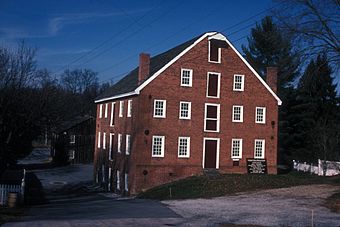Union Mills Homestead Historic District facts for kids
Quick facts for kids |
|
|
Union Mills Homestead Historic District
|
|

in 1971
|
|
| Location | Jct. of U.S. 140 and Deep Run Rd., Westminster, Maryland |
|---|---|
| Area | 279 acres (113 ha) |
| Built by | Shriver, Andrew; Schriver, David |
| NRHP reference No. | 71000371 |
| Added to NRHP | January 25, 1971 |
The Union Mills Homestead Historic District is a very special historical place located near Westminster, Maryland, in Carroll County, Maryland. It's like a time capsule that shows what life was like many years ago. This district includes several old buildings that tell the story of the Shriver family, who lived there for a very long time.
Contents
What is the Union Mills Homestead?
The Union Mills Homestead is a collection of historic buildings. It includes the main family house, a large brick grist mill (which grinds grain into flour), and parts of an old tannery where leather was made. There's also a special bridge called a Bollman-design bridge. All these buildings together make up the historic district.
A Look Back in Time: The Shriver Family History
The Shriver Homestead was built way back in 1797 by two brothers, Andrew and David Shriver. What's really amazing is that the Shriver family lived in this house for six generations! That means many different family members lived there, one after another, for over 200 years.
The mill, also built in 1797, is a big building made of bricks. These bricks were made right there in the local area. The way the bricks are laid shows different patterns, like "Flemish bond" and "common bond," which were popular building styles back then.
The Civil War Connection
The Union Mills Homestead played a small but interesting part in the American Civil War. On June 30, 1863, a famous Confederate general named J.E.B. Stuart and his soldiers camped at Union Mills. Some of the Shriver family members welcomed him. The very next day, a Union general named James Barnes and his soldiers from the Army of the Potomac arrived at the same spot. Other members of the Shriver family welcomed and entertained him. It's quite unique that both sides of the war visited the same family's home on back-to-back days!
Becoming a Historic Landmark
Because of its long history and important buildings, the Union Mills Homestead was added to the National Register of Historic Places in 1971. This means it's officially recognized as a place important to the history of the United States.
Today, the Union Mills Homestead is a museum. It's run by a non-profit group called the Union Mills Homestead Foundation. They work hard to keep the buildings safe and teach people about American history and culture. All the money they raise goes towards preserving and restoring this amazing historical site.
How the Shriver Homestead Was Built
The Shriver brothers chose a great spot for their homestead. They bought a large piece of land along Big Pipe Creek, which had a strong flow of water perfect for a mill. The land also had gentle hills for farming and lots of black oak trees, which were important for getting "tanbark" to make leather at a tannery.
In 1797, the brothers made plans to build their businesses and homes.
Building the Mills
On January 25, 1797, Andrew and David Shriver hired a mill builder named John Mong. He agreed to build "a set of mills," which included a grist mill for grinding grain and a saw mill for cutting wood.
Soon after, on March 13, Jacob Keefer and John Eckert were hired to make bricks. They agreed to make at least 100,000 bricks for the mill! The brick kiln, where the bricks were baked, was set up near the creek.
Building the House
The Shriver family house also started being built in 1797. On January 26, they hired Henry Kohlstock to build a "small double house." This house was actually two small houses, each 14 by 17 feet, connected by a porch and a hallway. Each small house had one room upstairs and one room downstairs.
It's interesting to see how much things cost back then! For example, the carpenter's bill for labor on the house included:
- Lower floors: 5 dollars
- Upper floor (rough): 3 dollars
- Windows, frames, and sashes: 2 dollars each
- Doors and their frames: 2 dollars each
- Outside siding, stairs, porch, and other details: 3 dollars
- Painting: 6 dollars
The total cost for the carpenter's labor on the house was only eighty-six dollars! This shows how different prices were in 1797 compared to today.



